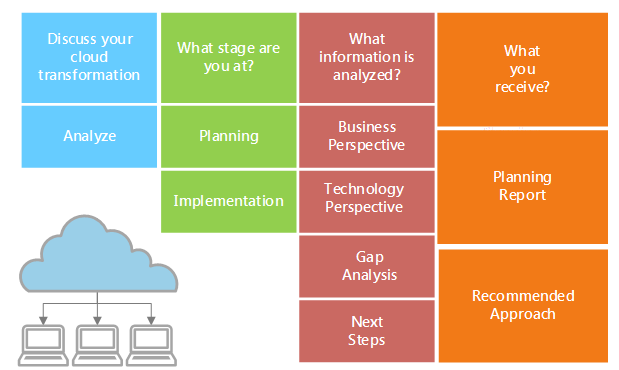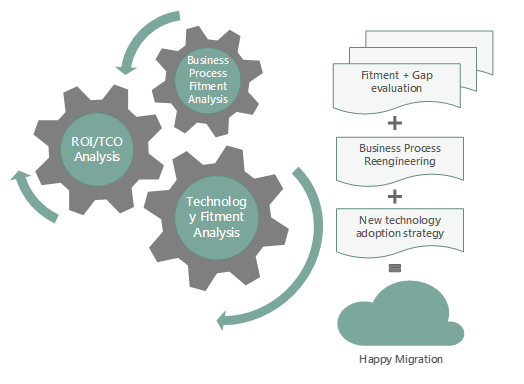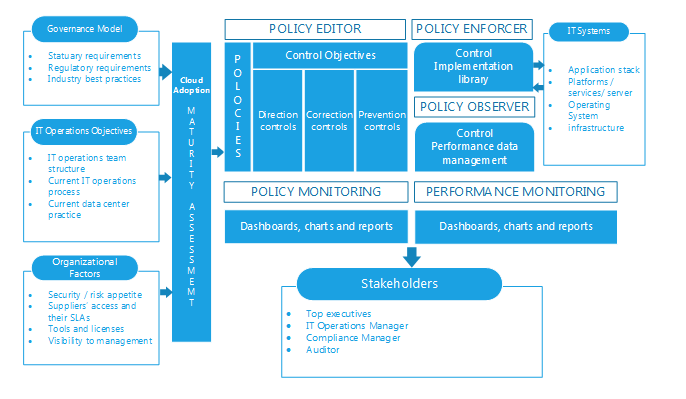Overview
As a part of the Digital Transformation Strategy, enterprises today are rapidly adapting to the cloud and planning to migrate their work load to cloud. They are not just embracing newest technologies like Big Data, Analytics and Enterprise Mobility but also rapidly transforming their business processes.
As a result of this, the legacy enterprise solutions such as these are increasingly stepping up in line with the changes in the market place. The whole gamut of IT is shifting from Information Management to Digital Transformation that requires extraordinary vision, planning and flawless execution.
Adoption of cloud seeks intensive planning and execution at both infrastructure and application level. Therefore, migration from legacy to cloud essentially requires three primary attributes - cloud orchestration, automation and governance. Cloud Factory makes this possible by using a policy driven management solution.
Cloud Assessment Process
Efficiency of the automation model

As migrating to cloud requires a lot of effort, an efficient and effective way to carry out this exercise would need a detailed cloud assessment process as depicted above.
Automating Cloud Migration
Migrating to cloud is an effort-intensive activity as it requires ample readiness assessment. Organizations therefore need to have an automated process and built analytics algorithm to quickly arrive at high level and drilled down reports of cloud readiness assessment. Cloud Factory automates this process and builds analytics algorithms with TCO and ROI analysis. Cloud Factory even automates the entire migration process to save migration costs from on-premise to cloud. It integrates many tools and creates a layer that cuts down technical difficulties in migration phase.
A highly automated migration process would save approximately 45% of workload migration cost as compared to on-premise to cloud. This is achieved by integrating open source tools and creating a layer to cut down technical difficulties in the migration process.
Enterprises can achieve this by using an approach that includes multi-platform and policy driven cloud orchestration and automation platform. Once the planning and TCO/ROI reports are ready, they can start working on the first phase of Cloud Migration as shown in the below picture
A highly automated migration process:

Cloud Orchestration, Automation and Governance
Enterprises looking at embracing cloud migration can benefit from multi-platform policy driven cloud orchestration and management solutions which helps them in their cloud governance strategy.
The orchestration layer allows for planned automation and provisioning tasks within a mixed cloud environment. It uses underneath Cloud APIs, focused on configuration, changes, security considerations, governance policies, change management, provisioning, monitoring, performance optimization and many other functions, which make the overall orchestration and management of a strategic cloud adoption process dramatically simple for cloud administrators.
“The multi-service cloud orchestration architecture provides a set of specifications and guidelines for creating and deploying a scalable, secure, and resilient infrastructure. This addresses enterprise needs of a complex cloud computing at all services levels.”
It helps organizations meet their strategic goals of achieving security, high-availability, visibility cost reduction and agility together using Policy Driven Automation (PDA).
Cloud orchestration solution typically contains a rich library of policies such as communication layer hardening policy, update maintenance policy, common service management policy, access management policy, performance monitoring policy, DR policy, log management policy and cloud monitoring policy.
Besides being a one-stop integrated solution for enterprises in all cloud support services, cloud automation and management also enables enterprises to build a secure public, private and hybrid clouds.
Several ecosystems such as Infrastructure as a service, Platform as a Service, Database as a Service, Identity Management as a Service, Infrastructure Provisioning as Service, Cloud Automation as a Service, Security Management as a Service, Cloud Analytics as a Service for public clouds gets supported and can be integrated under cloud orchestration.
“Using a policy driven cloud orchestration solution helps enterprises move from tactical day to day cloud operations to a strategic cloud adoption.”
Multi-Platform Policy Driven Cloud Orchestration and Management

Key Features
- Support for both Linux and Windows based workloads on all clouds
- Provision to users to manage the workloads in the self-service mode:
- Cloud assets provisioning, policy driven stop/pause, start capabilities
- Access to dashboards for monitoring infrastructure and alerts and management service
- Monitoring / security alerts and notifications
- Authorization based access to cloud infrastructure
- Policy and role based access to cloud infrastructure
- Policy enforcement
- Management of assets in cloud and hybrid cloud using APIs for managing assets in cloud and third party utilities and tools
- Tracking of assets in central inventory with tags and the cost expenses
- Recommendations for scale up and scale down of various cloud services
- Backups and DR setup are maintained in cloud and tracked via DR and Backup configuration and the required inventory is maintained to ensure the RPO
- Management of physical, virtual, and cloud asset to help companies simplify the management of licenses, SSL certificates, maintenance contracts, and entitlements
- Dashboards for relevant stakeholders for live status of their area of concern
- Assessment of maturity level of cloud adoption and recommendation for next level of maturity
Key Benefits
“Cloud Factory’s multi-platform policy driven cloud orchestration and management platform helps enterprise in their cloud governance strategy with many benefits.”
- Orchestration Automation: Cloud Factory’s orchestration “layer” allows for planned automation and provisioning tasks within a mixed cloud environment. It uses underneath Cloud APIs that make the overall orchestration process dramatically simple for cloud administrators.
- Policy Driven Automation: Cloud Factory’s policy driven cloud orchestration solution helps in strategic cloud adoption. It enables companies to meet their strategic goals of achieving high security, high-availability, visibility, and cost reduction and agility together using Policy Driven Automation (PDA).
- Library Of Policies: Cloud Factory has rich library of policies such as OS and communication layer hardening policy, update maintenance policy, common service management policy, access management policy, performance monitoring policy, DR policy, Log management policy, Cloud monitoring policy and others.
- Integrated Solutions Ecosystem: Cloud Factory has a one stop integrated solution for enterprises to support virtually all the services in a cloud ecosystem for public clouds.
- Management Frameworks And Templates: Cloud Factory’s multi-service cloud orchestration (MSCO) architecture provides cloud management templates in the form of a set of specifications and guidelines for creating and deploying a scalable, secure, and resilient infrastructure to address enterprise needs of complex cloud computing at all services levels. It enables enterprises to build secure public, private and hybrid clouds.
Bottom line
The task of improving IT performance and efficacy has never been easy. Legacy and old processes and infrastructure usually stand in the way of improving application delivery.
To enhance and improve the software delivery effectiveness, IT teams consistently require good automation, governance, management and architecture best practices.
The cloud factory is the next step for evolution in cloud that bridges the gaps in disconnected and disjointed application development tooling. Cloud factory model forges agile approach to application design. It provides a cloud based, automated, and DevOps method to delivery.




